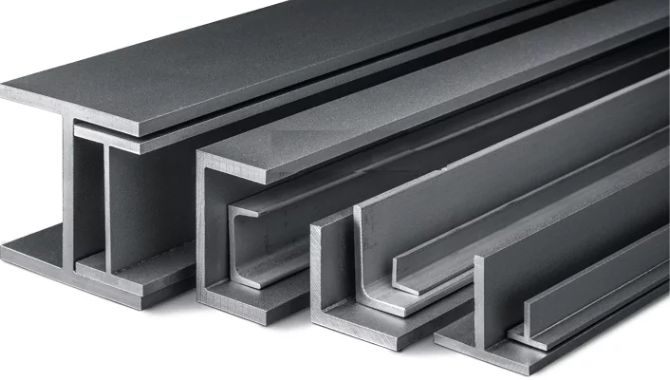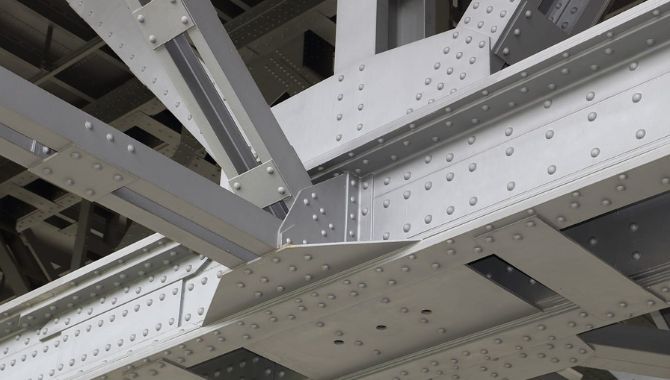Ever wondered why some steel beams look like an “H,” some like an “S” and others a “W,”? These small differences can decide the strength and cost of your project. Today we will see the differences between these three beam types.
What are the Common Kinds of Steel Beams?

They are the backbone of many structures. These beams come in different sizes and shapes to meet different strength needs. The three main types are “H”, “W” and “S”.
H-Beams
H-beams possess a characteristic H-shaped cross-section. Two parallel flanges of same width attach to a central web and make a perpendicular structure. These beams outshine in stability and strength due to their wider flanges and thicker web. This design let these beams support heavier loads over shorter spans as opposed to other beam types. Tall buildings mostly use them in the role of HP-beams or bearing piles for foundation support.
W Beams
Also known as wide flange beams, “W” beams are defined by parallel outer and inner flange surfaces. Their depth mostly exceeds the width of their flanges. W beams have thicker flanges than webs and this increases their resistance to bending stress. They come in a broad range of standard sizes from the small W4x13 to the massive W44x335. The design of W beams gives outstanding load-bearing capacity. Parallel flanges contribute to simplified fabrication processes and connections.
S Beams (Standard Beams)
S beams set themselves apart with their distinct tapered flange design. The inner flange surfaces incline at around 16.67% and this creates a curved appearance where flanges join the web. This design results in somewhat thicker cross-section at the top compared to the bottom. This gives S beams their signature S shape when seen from the end. Of the three beam types, S type display the most limited size options. Their tapered flanges make them particularly successful for vertical load-bearing applications like in bridges. The inclined inner surfaces contribute to improved distribution of vertical loads from the upper to the lower flange.
Comparative Analysis: H Beams vs. W Beams vs. S Beams

There are many unique parameters that distinguish H, W and S beams from one another. Now we’ll look at some of these features.
Shape and Structure
H-beams have a consistent thickness across their cross-section. Their flanges are approximately equal to the beam depth. Two parallel flanges connect to a central web and form a symmetrical H-shape. W- type has parallel flange surfaces and has thicker flanges than the web. Their depth is usually more than the flange width which results in a pronounced I-shape with wider flanges.
S-beams differ from the other two beam types because of their unusual tapered flange design. The inner flange surfaces slope at 16.67%. S-beams have a little thicker cross-sectional area at the top versus the bottom. This creates their distinctive S shape when viewed from the end. The web of S-beams is usually thinner than H and W beams and the flanges taper gradually from the web to the edges.
Load-Bearing Capacity
“H” beams shine in load-bearing capacity and can support spans up to 330 ft. This outdoes both W and S beams. W-beams, while not equaling H-beams in span, are good at resisting bending from their optimized cross-section. “S”-beams usually have lower load-bearing capacities than H and W beams, but are better for weight efficiency.
Manufacturing Process
All three beam types are commonly made through hot rolling but with some differences. During H beams’ manufacturing, steel billets are heated and are passed through a series of rollers to get the H-shape.
W-beams are made using caliber rolls to form their cross-sectional shape. Beam blanks are heated and rolled out. W-beams usually need strict tolerances because of their wider flanges and this requires more controlled rolling. S-beams also use hot rolling but with tweaks and careful controlling to make their distinct tapered flanges.
Tapered Legs

S-beams stand out for their tapered legs that are sloped at a degree angle on the inner flange surfaces. This slope runs along the legs and makes rounded edges where these legs join the web. Unlike S-beams, H-beams and W-beams usually have parallel outer and inner flanges. This results in more angular connections between the flanges and the web.
This design of W-beams and H-beams provides consistent thickness and facilitates easier connections in construction. S-beams’ tapered legs have some advantages for specific uses like for better distributing vertical loads from top to bottom flanges. But this design can also make joining of S-beams to other structures more difficult when compared to the straight edges of H-beams and W-beams.
Leg Width
The leg width of structural beams differ greatly across types. S-beams usually have the narrowest legs that range from 2.330 inches (for S 3 x 5.7) to 8.050 inches (for S 24 x 121). Most S-beams fall between 3 and 7 inches in leg width.
W-beams come in many sizes and their leg width spans from 4.06(W4 series) to 14.5 inches(W14 series) according to ASTM A6 standards. H-beams commonly have leg widths close to their depths. These differences in leg width help in determining load-bearing capacity and structural integrity of each beam.
Flanges
Flange characteristics also set these beam types apart. W-beams are known for their wide flanges that are parallel and much thicker than their web. This shape boosts resistance to bending stress. H-beams have flanges roughly equal in width to the beam depth which gives them a balanced structure. And flanges of S-beams are tapered and their width is less than the depth of beam.
Ease of Fabrication and Construction

Among the three types, W-beams usually deliver the simplest construction and fabrication process. Their consistent thickness and parallel flanges make connections easier and fitting extra parts simpler. H-beams though they are similar to W-beams, may need more accurate fabrication because of their bigger size and heavier weight.
S-beams give the most hurdles in fabrication and construction because of their tapered flanges. The 16.67% slope on S-beam flanges need specific connection information and can make adding attachments very difficult. This complexity can increase labor cost and time in construction projects.
Flexibility in Design
W-beams give engineers the most flexibility in design with the largest range of weight capacities and sizes among the three beams. This variety lets engineers optimize beam choice for particular project needs, likely cutting down total building expenses and weight. H-beams, although less flexible than W-beams, still give good design options particularly for heavy duty load-bearing.
S-beams provide the least flexibility among the three because of their tapered flanges and standardized dimensions. But their distinct profile can be helpful in some applications, like crane rails or where drainage matters. There they present solutions that H-beams and W-beams may not be able to provide.
Cost and Efficiency
Initial costs are usually highest for H-beams because of their larger weight and size. But their greater strength usually means you need fewer beams which will likely decrease the total expenses of a project. W-beams balance performance and cost by giving extraordinary lateral stability and standardized sizes that easily integrate into plans. S-beams are usually the most affordable of the three for smaller projects or in applications that need lower weight.
The efficiency of each beam type is closely tied to its structural features. H beams excel in high torsion resistance scenarios and column applications. W beams are perfect for long spans, and S beams are best for lighter loads and shorter spans.
Applications

H-beams work well for heavy duty uses like bridges, industrial buildings and high-rises. Their strength makes them best for columns in skyscrapers and foundation piles. W-beams are known for being versatile. They’re mostly used as highway bridge girders, in industrial and commercial buildings and big span structures. W-beams benefit from their great lateral stability and load-bearing capacity.
S-beams mainly see use in residential construction, roof supports and light commercial buildings. Their suitability for lighter loads and compact size make them perfect here. The shipbuilding industry also uses S-beams.
| Aspect | H-beam | W-beam | S-beam |
| Shape and Structure | H-shaped cross-section with parallel web and flanges | Similar to H-beam, but with wider flanges relative to web height | Tapered legs and sloping inner flanges |
| Load-Bearing Capacity and Flexibility | Highest load-bearing capacity, least flexible | Slightly lower capacity than H-beam, more flexible | Lower capacity than both H and W, good flexibility through cutting |
| Manufacturing Process | Made using hot rolling method | Formed utilizing rolling method with caliber rolls | Hot/cold rolled with different roll shapes to create taper |
| Tapered Legs | No taper, parallel flanges | No taper, parallel flanges like H-beam | Tapered legs with 2:12 slope on inner flange surfaces |
| Leg Width | Width approximately equal to beam depth | Wider flanges compared to H-beam | Narrower legs compared to both H and W beams |
| Flanges | Thick, parallel flanges | Similar thickness to H-beam, but wider | Thinner than H and W, with sloping inner surfaces |
| Ease of Fabrication and Construction | Challenging to fabricate due to heaviest weight | Easier to fabricate than H-beam | Difficult to fabricate due to tapered flanges |
| Flexibility in Design | Least flexible due to bulkier structure | More flexible than H-beam, widest size range | More flexible than H-beam, but less size options than W-beam |
| Cost and Efficiency | Highest cost due to more material, most efficient for heavy loads | Lower cost than H-beam, efficient for various loads | Lowest cost of the three, efficient for lighter loads |
| Applications | Heavy-duty construction, skyscrapers, load-bearing columns | More versatile than H-beam: general construction, buildings, bridges | Lighter structural support, shipbuilding, where H and W are overengineered |
Conclusion

In summary, H-beams, W-beams and S-beams each have special features suitable for different uses. H-beams stand out in heavy-duty builds, S-beams work great for niche applications and lighter loads and W-beams give ease of fabrication and is flexible. Knowing these differences is very important to choose the right beam type.
For any kind of custom fabrication project, you should get in touch with KDM Fabrication. Our team will help you in selecting the right beam for your project.
FAQs
How to Choose the Right Beam?
Picking the correct beam depends on a few things like span length, the needed load capacity and your project’s distinct needs. Look at aspects such as cost, strength-to-weight ratio and how well the beam works with your building method. And lastly talk to a structural engineer to find the best beam type for your project’s special requirements.
What shape of beam is strongest?
The H-beam is usually seen as the strongest beam type because it stands up to bending forces and spreads loads proficiently.




